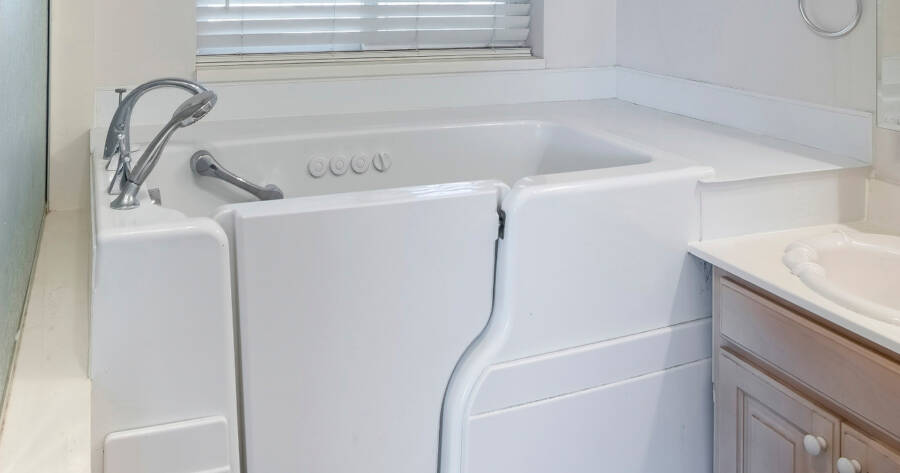As people age, routine activities like bathing can become more challenging, particularly for individuals with mobility concerns or health conditions. Walk-in bathtubs offer a safer and more accessible option, providing potential benefits while reducing the risk of accidents.
Improving Safety and Reducing Fall Risks
Falls are a significant concern for seniors, especially in the bathroom, where wet surfaces can increase the likelihood of slipping. Walk-in bathtubs are designed to address this issue by offering easier access through doors that eliminate the need to step over high edges, which is common in traditional tubs.
For seniors who are prone to balance issues or have difficulty lifting their legs, the lower threshold of a walk-in tub could provide a safer alternative. Additionally, many models come equipped with built-in grab bars, slip-resistant surfaces, and seats, further reducing the chances of falls. While these features may not completely eliminate the risk of accidents, they could certainly lessen it, offering peace of mind to both seniors and their caregivers.1
Enhancing Independence and Dignity
Maintaining personal independence is a priority for many seniors, and bathing is one activity where people often prefer privacy. Walk-in tubs are designed to be accessible for those with limited mobility, potentially reducing the need for assistance from family members or home care aides.
Seniors who may struggle with the logistics of getting in and out of a traditional bathtub might find walk-in tubs easier to manage on their own. Built-in seating can help alleviate concerns about standing for long periods, and hand-held shower attachments make it possible to bathe without the need for complete immersion in water.
The ability to bathe independently could contribute to a sense of dignity, which is important for emotional well-being. While walk-in tubs won’t be suitable for every individual’s needs, they could make a significant difference for those who prioritize autonomy in their daily routines.
Potential Therapeutic Benefits
Many walk-in bathtubs offer additional features that could provide therapeutic benefits. Some models include hydrotherapy jets, which might help soothe muscle tension, improve circulation, and provide relief from certain types of pain, such as arthritis or fibromyalgia. These warm water jets can offer gentle massaging effects, which some individuals may find comforting.2
The buoyancy created by water immersion can also help reduce pressure on joints, possibly offering temporary relief from discomfort or stiffness. Seniors with chronic pain or limited mobility may find this feature especially appealing, though it’s important to consult with healthcare professionals before relying on hydrotherapy as a treatment option. Hydrotherapy in walk-in tubs should not be seen as a guaranteed solution but rather as a potential complement to other forms of pain management.
Aiding Personal Hygiene
For seniors, maintaining personal hygiene can become difficult due to physical limitations. Walk-in bathtubs provide a more accessible option, potentially making it easier for older adults to maintain regular bathing habits, which can contribute to overall health and well-being.
Many walk-in tubs are designed with easy-to-use faucets and temperature controls, allowing users to regulate water settings with less effort. Additionally, the seated position reduces the risk of exhaustion, making it feasible for individuals to take their time while bathing without overexerting themselves.
However, it’s important to recognize that walk-in tubs may not fully resolve all hygiene challenges. Those with severe mobility issues or cognitive impairments may still require assistance, but for many, this type of tub could make personal care more manageable.
Offering Comfort and Relaxation
Beyond the practical benefits, walk-in tubs may enhance overall comfort and relaxation during the bathing experience. Warm water immersion has long been associated with stress relief, and for seniors, a relaxing bath can offer moments of respite from daily challenges.
Some models come with optional features like aromatherapy or chromotherapy (light therapy), which could further enhance relaxation, though these features may not be necessary for everyone. For seniors who view bath time as an opportunity for unwinding, the additional comfort of a walk-in tub could make a significant difference.
It’s worth noting, though, that these additional features may increase the cost of the tub, and individuals should carefully assess whether the potential benefits align with their specific needs.
Learn More Today!
Walk-in bathtubs offer a range of potential benefits for seniors, from improved safety and independence to enhanced comfort and therapeutic options. While they are not a one-size-fits-all solution, walk-in tubs could be a valuable addition for seniors looking to maintain their quality of life. However, it’s important to carefully evaluate individual needs, consult with professionals, and consider both the benefits and the costs before making a final decision.
